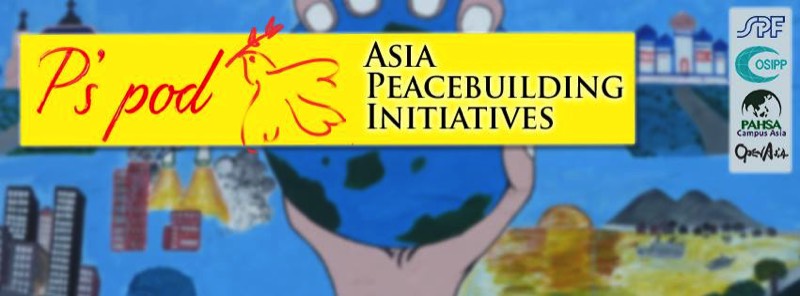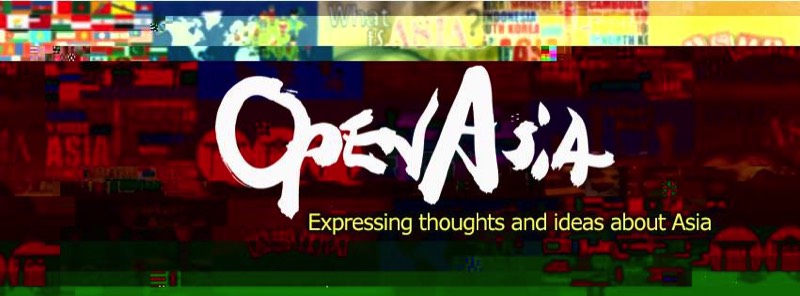Essays: PAHSA Semester Program Southeast Asia
Upon completion of the PAHSA Semester Program, students from Japanese universities wrote short reports about their time as exchange students at one of the four PAHSA consortium universities in Southeast Asia. In the reports they detail their study experiences, the cultural differences while living away from home, and how they might benefit from the experience of the PAHSA program in the long-term. Please note that some of the reports have been edited and slightly modified for the web.
PAHSA: A pivotal role in my life as an aspiring Filipino scholar
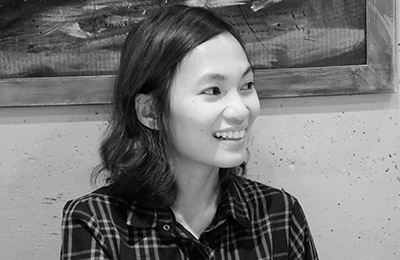
OSIPP, Osaka University
@ RSIS, Singapore
The PAHSA Singapore semester program is the last of the three PAHSA programs I have joined since 2013. I participated in the Hiroshima short-term and Osaka long-term programs as a student from a Southeast Asian University. What began with a mindless curiosity about the peculiar land of the rising sun and Naruto turned into a serious research project that made me do what was previously unthinkable: study about Japanese society in a Japanese university and spend the next three years of my life in a country I had never dreamt of visiting, even as a tourist. I am now a graduate student at Osaka University, and was fortunately granted the opportunity to visit a Southeast Asian university as a student from a Japan. Needless to say, PAHSA played a pivotal role in my life as a young, aspiring Filipino scholar.
Through my PAHSA experiences, I came to realize that colonialism weaves together the Philippines, Singapore and Japan. And because of such commonality, I could use Singapore and Japan as a mirror to see the bigger picture of my country. The history of the Philippines is built upon colonialism after colonialism from the 16th to 20th century, while Singapore had their share of British rule in the 19th and 20th centuries. As these two countries were subjugated under Western colonial rule, the Japanese imperial army violently built its own empire in Asia, and eventually lost to the Allied Powers. After the Second World War, the Philippines gained independence, Singapore dealt with the British colonial residue and Japan became a pseudo-colony of the United States. In the postwar era, Japan became the model for Singapore’s developmental state, Singapore became an aspiration for many Filipinos and alas, the Philippines’ only chance of being a model for other nations, the EDSA Revolution of 1989, is now becoming a lesson on failed revolutions and the persistence of oligarchy.
Colonialism is everywhere in these countries. The buildings, the food, the political structures are all are telling that the past cannot and will not leave and that appropriation is the best way to deal with its stickiness. On the surface I can say that Japan and Singapore did it well. As my jaw drops in awe at the efficient transportation systems in Japan and Singapore, the clean streets and spotless public areas laced with traditional and colonial buildings, I cannot help but gripe about the condition of my country. If I were to concoct a mixture for my ideal Philippines I would pour in some Japanese national pride and politeness, sprinkle a bit of Singaporean bureaucratic discipline and douse it with the Japanese value for agriculture. I would also remodel the Manila streets based on the Japanese design – unimposing structures built with precision, Tadao Ando-inspired architecture, mixed with nature and the charming ruins of old buildings.
But there is something lacking in the image I see when I look at these two, considerably the most successful states in East Asia, a lack which I can only see in the painful smiles and discomfiting barrage of the Filipinos. My PAHSA experience made me realize that what we have is the gifts of democracy that former Singaporean Prime Minister once castigated, and a certain happiness is something that Japan and Singapore could perhaps never have. Without my exposure to these two East Asian countries, I would have joined the expanding pro-authoritarianism bandwagon at home. Without studying Japan’s history, I would not have seen it as a fellow Asian country, which despite a high GDP and advance technology, suffered feelings of inferiority under the Western gaze. Without my long stay in Singapore, I would not have seen why some Filipinos would choose an iron fist over a freedom fighter, and why I would prefer my country not to be a complete replica of the city-state.
What emerged from my experience as both an insider and outsider in these three countries is; are we prepared to sacrifice what we have for what we desire to become? Meiji Japan took this question rather too seriously and learned the answer the hard way.
I will not end my PAHSA experience with a straightforward peace and human security policy recommendation. PAHSA, I think was not made for that and deserves more than that. How can a 5-year long project tackle the problem of war and aggression rooted in long, insufferable colonial histories? I obviously did not spend the Japanese taxpayers’ money by coming up with assessment tools or indicators for peace – the world has enough of these projects already. I would rather end it by beginning a personal research project that could contribute to the understanding of entangled histories between the past and present, between Japan, my region and my country.
It is astonishing to see surprised Japanese and Southeast Asian students who joined PAHSA in the Philippines when they find out that Japan was not just about Pikachu, Hello Kitty and robots. Yet it is also relieving to see myself and other students gain a better understanding of Japan and how close the Southeast Asians are to this country and vice versa. These may be increments compared to the awesome appeal of policy commentaries, yet at least we can avoid being mere receivers of their message and become a critical audience.
My only hope is that PAHSA does not end with the project contract. I must admit, there is nothing extravagant about this undertaking. It is not about building networks with top-ranking universities, nor is it just about showcasing the beauty of Japan. In fact, it invites the participants to see the ugly side of the war the Japanese helped create, and how the pursuit of imperial greatness can lead to nothing but the destruction of humanity. Yet PAHSA is an ambitious project. It is not easy to convince people that to come into terms with the brutality of war and to vow never to plunge into war ever again are two of the most effective ways to promote peace and human security. How can one promote peace when one does not understand the need for it?
PAHSA is consistent with Japan’s postwar promise of promoting peace among nations. I hope Prime Minister Shinzo Abe had a chance to join us in Hiroshima, or visit Manila and listen to the meaningful lectures and discussions we had. If he wants to promote peace, then PAHSA might help him to understand first why there is a need for peace.
Through my PAHSA experiences, I came to realize that colonialism weaves together the Philippines, Singapore and Japan. And because of such commonality, I could use Singapore and Japan as a mirror to see the bigger picture of my country. The history of the Philippines is built upon colonialism after colonialism from the 16th to 20th century, while Singapore had their share of British rule in the 19th and 20th centuries. As these two countries were subjugated under Western colonial rule, the Japanese imperial army violently built its own empire in Asia, and eventually lost to the Allied Powers. After the Second World War, the Philippines gained independence, Singapore dealt with the British colonial residue and Japan became a pseudo-colony of the United States. In the postwar era, Japan became the model for Singapore’s developmental state, Singapore became an aspiration for many Filipinos and alas, the Philippines’ only chance of being a model for other nations, the EDSA Revolution of 1989, is now becoming a lesson on failed revolutions and the persistence of oligarchy.
Colonialism is everywhere in these countries. The buildings, the food, the political structures are all are telling that the past cannot and will not leave and that appropriation is the best way to deal with its stickiness. On the surface I can say that Japan and Singapore did it well. As my jaw drops in awe at the efficient transportation systems in Japan and Singapore, the clean streets and spotless public areas laced with traditional and colonial buildings, I cannot help but gripe about the condition of my country. If I were to concoct a mixture for my ideal Philippines I would pour in some Japanese national pride and politeness, sprinkle a bit of Singaporean bureaucratic discipline and douse it with the Japanese value for agriculture. I would also remodel the Manila streets based on the Japanese design – unimposing structures built with precision, Tadao Ando-inspired architecture, mixed with nature and the charming ruins of old buildings.
But there is something lacking in the image I see when I look at these two, considerably the most successful states in East Asia, a lack which I can only see in the painful smiles and discomfiting barrage of the Filipinos. My PAHSA experience made me realize that what we have is the gifts of democracy that former Singaporean Prime Minister once castigated, and a certain happiness is something that Japan and Singapore could perhaps never have. Without my exposure to these two East Asian countries, I would have joined the expanding pro-authoritarianism bandwagon at home. Without studying Japan’s history, I would not have seen it as a fellow Asian country, which despite a high GDP and advance technology, suffered feelings of inferiority under the Western gaze. Without my long stay in Singapore, I would not have seen why some Filipinos would choose an iron fist over a freedom fighter, and why I would prefer my country not to be a complete replica of the city-state.
What emerged from my experience as both an insider and outsider in these three countries is; are we prepared to sacrifice what we have for what we desire to become? Meiji Japan took this question rather too seriously and learned the answer the hard way.
I will not end my PAHSA experience with a straightforward peace and human security policy recommendation. PAHSA, I think was not made for that and deserves more than that. How can a 5-year long project tackle the problem of war and aggression rooted in long, insufferable colonial histories? I obviously did not spend the Japanese taxpayers’ money by coming up with assessment tools or indicators for peace – the world has enough of these projects already. I would rather end it by beginning a personal research project that could contribute to the understanding of entangled histories between the past and present, between Japan, my region and my country.
It is astonishing to see surprised Japanese and Southeast Asian students who joined PAHSA in the Philippines when they find out that Japan was not just about Pikachu, Hello Kitty and robots. Yet it is also relieving to see myself and other students gain a better understanding of Japan and how close the Southeast Asians are to this country and vice versa. These may be increments compared to the awesome appeal of policy commentaries, yet at least we can avoid being mere receivers of their message and become a critical audience.
My only hope is that PAHSA does not end with the project contract. I must admit, there is nothing extravagant about this undertaking. It is not about building networks with top-ranking universities, nor is it just about showcasing the beauty of Japan. In fact, it invites the participants to see the ugly side of the war the Japanese helped create, and how the pursuit of imperial greatness can lead to nothing but the destruction of humanity. Yet PAHSA is an ambitious project. It is not easy to convince people that to come into terms with the brutality of war and to vow never to plunge into war ever again are two of the most effective ways to promote peace and human security. How can one promote peace when one does not understand the need for it?
PAHSA is consistent with Japan’s postwar promise of promoting peace among nations. I hope Prime Minister Shinzo Abe had a chance to join us in Hiroshima, or visit Manila and listen to the meaningful lectures and discussions we had. If he wants to promote peace, then PAHSA might help him to understand first why there is a need for peace.
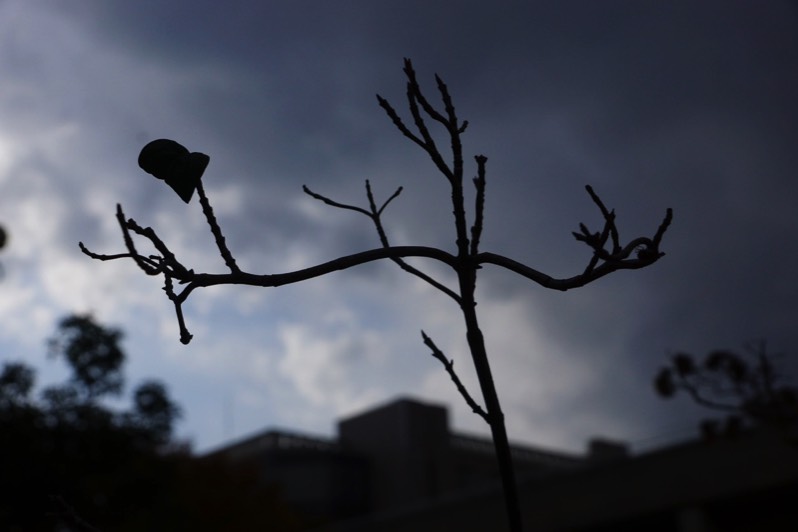
Late November 2013. OSIPP standing in the background at the Toyonaka Campus, Osaka University
Read Mina Untalan essay that was written after she attended the PAHSA Hiroshima Short Program:
“The Caution of Collective Memory: Why Japan’s 1947 Constitution is Worth Fighting for”
Examining Contemporary Thai Society and Politics
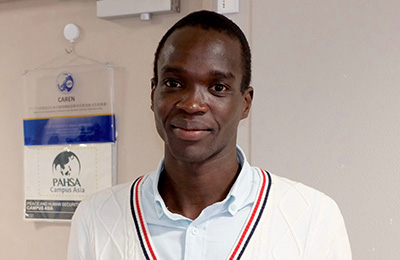
OSIPP, Osaka University
@ Chiang Mai University
Thailand
Thailand is a country with a long history of statehood. It is Southeast Asia’s only country that was never directly colonized. However, despite being a sovereign monarchy and having started to transform into a modern state in the 19th century under the charismatic King Chulalongkorn, and later transforming into a constitutional Monarchy in 1932, Thailand is still far from a stable kingdom. The country has been on a roller coaster of democratic transition and democratic regression for many decades.
Thailand’s contemporary political features have been characterized by persistent political instability that has resulted in several military takeovers, protests, violent crackdowns, curfews, repeated abrogation and changes of constitutions. Since the first coup in 1932, the country has witness around 19 successful or attempted coups d'états, with the latest successful putsch taking place in 2014. The country has changed constitutions 20 times, conducted numerous elections, and has had countless shaky governing coalitions.
Thailand’s contemporary political features have been characterized by persistent political instability that has resulted in several military takeovers, protests, violent crackdowns, curfews, repeated abrogation and changes of constitutions. Since the first coup in 1932, the country has witness around 19 successful or attempted coups d'états, with the latest successful putsch taking place in 2014. The country has changed constitutions 20 times, conducted numerous elections, and has had countless shaky governing coalitions.
Coups and More Coups
Past coups were staged under different circumstances, but the common theme has been power grabs to retain authority and influence in Thai politics for the old political elite. On many occasions, these events took place in collaboration with or acquiescence of Thailand’s royal family. Most notable triggers for coups in Thailand were generally related to factionalism within the army, alleged political corruption and scandals, the failure of weak civilian governments to promote good governance, and now, with King Bhumibol Adulyadej in the twilight of his reign, mounting uncertainty about the looming end of the Bhumibol era.
Thailand’s royal family has long played a key role in Thai politics, especially by maintaining close relations with the military, even during periods of civilian rule. Over the years, Bhumibol has managed to become an indispensable partner of the generals, and they have cast themselves as the monarchy’s ultimate defenders. The Royal House also has a network of elite patrons and cronies, which, it has been suggested, has engineered unconstitutional change of governments that may have threatened to curtail their prestige and influence.
Having said that, the Thai Monarch is viewed by many Thais as a symbol of unity and source of order and stability in the Kingdom. At times of political upheaval and economic crisis, most Thais put their faith in the monarchy and expect the king to restore order, stability, and ameliorate the economic woes. The lèse majesté law protects the Thai monarchy, and criticizing the Royal House almost amounts to treason and results in long jail terms. In recent times, it has been suggested that the Thai regime has used the lèse majesté law heavy-handedly to silence critics. Recently, it has been reported that a factory worker in Thailand faces up to 37 years in jail for insulting the military rulers on social media and mocking the king’s dog.
Without doubt, the two most influential and powerful political forces in Thailand are the army and the Royal House. The two entities are almost inseparable with the Royal Thai Army viewing one of its important roles as protector of the monarchy. This can be inferred from the army slogan: "For the Nation, Religions, King, and People.’’ Thailand is a strong state that obviously lacks democratic accountability and has weakness on the part of the rule of law, as laws are not binding on politically powerful elites. As Fukuyama argues, a successful modern state should have three political institutions functioning in the right balance: State, rule of law and accountable government (Fukuyama, 2014). Thailand also shows aspects of Weberian Patrimonial State. The monarch and the army run the country.
Thailand’s royal family has long played a key role in Thai politics, especially by maintaining close relations with the military, even during periods of civilian rule. Over the years, Bhumibol has managed to become an indispensable partner of the generals, and they have cast themselves as the monarchy’s ultimate defenders. The Royal House also has a network of elite patrons and cronies, which, it has been suggested, has engineered unconstitutional change of governments that may have threatened to curtail their prestige and influence.
Having said that, the Thai Monarch is viewed by many Thais as a symbol of unity and source of order and stability in the Kingdom. At times of political upheaval and economic crisis, most Thais put their faith in the monarchy and expect the king to restore order, stability, and ameliorate the economic woes. The lèse majesté law protects the Thai monarchy, and criticizing the Royal House almost amounts to treason and results in long jail terms. In recent times, it has been suggested that the Thai regime has used the lèse majesté law heavy-handedly to silence critics. Recently, it has been reported that a factory worker in Thailand faces up to 37 years in jail for insulting the military rulers on social media and mocking the king’s dog.
Without doubt, the two most influential and powerful political forces in Thailand are the army and the Royal House. The two entities are almost inseparable with the Royal Thai Army viewing one of its important roles as protector of the monarchy. This can be inferred from the army slogan: "For the Nation, Religions, King, and People.’’ Thailand is a strong state that obviously lacks democratic accountability and has weakness on the part of the rule of law, as laws are not binding on politically powerful elites. As Fukuyama argues, a successful modern state should have three political institutions functioning in the right balance: State, rule of law and accountable government (Fukuyama, 2014). Thailand also shows aspects of Weberian Patrimonial State. The monarch and the army run the country.
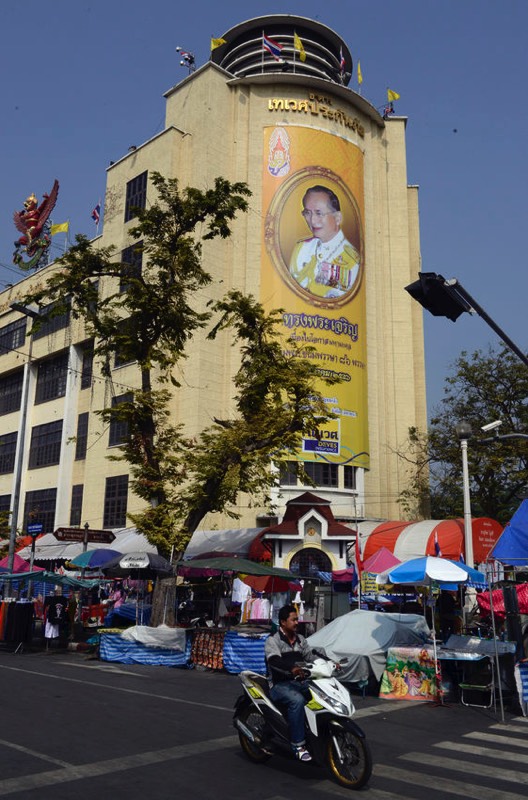
A picture of King Bhumibol on a building Banglamphu district in the Thai capital Bangkok
The Monarchy
The significance of the monarchy in Thai society is upheld and perpetuated through various means such as through the educational system. At schools, students are mostly taught a version of Thai history and culture with a royalist slant that offers Bangkok-centered narratives, portraying Thailand as if it is a homogeneous society thus ignoring the rich history and diversity in the country that might not fit the ‘official’ narrative. This also takes place through the ubiquitous presence of portraits of the royal family or the monarch which are displayed in every public office, in schools, inside public universities’ offices, on the streets of the cities across Thailand, on the banknotes and coins, on overpasses, and in the restaurants and other public places.
Surprisingly, amid all the political instability and obstacles to democratization, Thailand has not degenerated into protracted chaos. Except during WWII, the short-lived communist skirmishes in the 1960s and 70s, and the on-going conflict in the majority-Muslim provinces in Thailand’s Deep South, there is an atmosphere of order and stability in the country. In past decades, Thailand, in times other than the Asian financial crisis, has been developing steadily, and was considered an upper middle-income country by the World Bank in 2011.
But although the country has been industrializing steadily, it is now lagging slightly when compared to other emerging economies in Asia Pacific as its society ages. Additionally, besides inappropriate macroeconomic and development policies, political uncertainties and bad governance are also taking their tolls. Thailand ranks 76 in the 2015 Corruption perception index. Corruption stifles economic growth and seriously impedes on development as public funds are misappropriated. Corruption also scares away foreign investors, thus affect FDI gains. It also engenders political instability, and Thailand has a short fuse; political crises and coups are ever conspicuous.
Surprisingly, amid all the political instability and obstacles to democratization, Thailand has not degenerated into protracted chaos. Except during WWII, the short-lived communist skirmishes in the 1960s and 70s, and the on-going conflict in the majority-Muslim provinces in Thailand’s Deep South, there is an atmosphere of order and stability in the country. In past decades, Thailand, in times other than the Asian financial crisis, has been developing steadily, and was considered an upper middle-income country by the World Bank in 2011.
But although the country has been industrializing steadily, it is now lagging slightly when compared to other emerging economies in Asia Pacific as its society ages. Additionally, besides inappropriate macroeconomic and development policies, political uncertainties and bad governance are also taking their tolls. Thailand ranks 76 in the 2015 Corruption perception index. Corruption stifles economic growth and seriously impedes on development as public funds are misappropriated. Corruption also scares away foreign investors, thus affect FDI gains. It also engenders political instability, and Thailand has a short fuse; political crises and coups are ever conspicuous.
Human Development Progress
Thailand has made remarkable progress in terms of human development indicators and poverty reduction specially compared to mainland Southeast Asian countries. It managed to raise the life expectancy rate to around 75 years, reduce population in multidimensional poverty to 1.01%, raise literacy rate to above 98%, and significantly reduced maternal and infant mortality rates.
TABLE: SELECTED FOOD SECURITY INDICATORS
| COUNTRIES | UNDERNOURISHED POPULATION | STUNTING IN CHILDREN UNDER 5 YEARS | CHILD MORTALITY RATE UNDER 5 YEARS | LEVEL |
| THAILAND | 19% (2000) 7.4% (2015) |
7.8% (2000) 16.3% (2015) |
2.3% (2000) 1.3% (2013) |
MODERATE |
| VIETNAM | 28.1% (2000) 11% (2015) |
43% (2000) 19.4% (2015) |
2.3% (2000) 1.3% (2013) |
MODERATE |
| MYANMAR | 52.4 % (2000) 14.2% (2015) |
40.8% (2000) 35.1% (2015) |
8% (2000) 5.1% (2013) |
SERIOUS |
| CAMBODIA | 32% (2000) 14.2% (2015) |
49.2% (2000) 32.4% (2015) |
11.1% (2000) 3.8% (2015) |
SERIOUS |
| LAO PDR | 39.2% (2000) 18.5% (2015) |
48.2% (2000) 43.8% (2015) |
11.7% (2000) 7.1% (2013) |
SERIOUS |
Data Source: International Food Policy Research Institute (IFPRI) : Welthungerhilfe (WHH) : 2015 Global Hunger Index
However, despite the progress above, development in Thailand has been uneven. There is disparity between the central regions of Bangkok and the other provinces, especially those in rural areas. Likewise, there is noticeable income and wealth inequality. Ethnic minorities in the north, those commonly known as ‘the hills tribes’ are particularly left behind in terms of human development and material wellbeing. Many members of these ethnic minorities have no land or formal education, especially the older generation. Many live in mountainous/upland areas or in government conservation areas and are only allowed to subsistence farm on small plots. Many hill peoples’ villages, lack basic infrastructure and have only primary healthcare centers and elementary schools at most. Similar pockets of disadvantaged peoples can be found in many rural areas.
A Progessive Society
Despite Thailand’s democratic and societal ills, socially and culturally, it is a very progressive society. Rapid cultural transformation is taking place, partly induced by the forces of globalization, modernization and other local factors.
In Thailand, one can find several different gender roles, identities and diverse visual markers of masculinity and femininity, and the term ‘ladyboy’ (a term used to refer to both effeminate gays and men who voluntarily undergo sexual/gender reassignment surgery) has become synonymous with Thai culture. Ladyboys informally use female and other nicknames but officially must use their male names because current Thai laws do not allow them to change their names nor allow same sex union. Although the LGBT community has a place in society and is widely socially accepted, it is legally not recognized.
In Thailand, one can find several different gender roles, identities and diverse visual markers of masculinity and femininity, and the term ‘ladyboy’ (a term used to refer to both effeminate gays and men who voluntarily undergo sexual/gender reassignment surgery) has become synonymous with Thai culture. Ladyboys informally use female and other nicknames but officially must use their male names because current Thai laws do not allow them to change their names nor allow same sex union. Although the LGBT community has a place in society and is widely socially accepted, it is legally not recognized.
Tourism and its Challenges
Thai tourism is vibrant and plays a significant role in Thailand’s formal and informal economic sectors. Major tourist attractions include cultural and historical monuments such as glittering centuries-old Buddhist temples, beautiful nature and natural attractions, beaches, warm and sunny weather, health tourism, sex tourism—given Thailand’s vibrant sex business—perhaps also Thai cuisine, Tropical fruits, relative safety, and the cost-effectiveness as a destination given that the Thai cost of living is relatively low.
Yet there are also the downsides to tourism. Apart from many young people being locked into low-income service jobs that are reliant on the tourist dollar, also in the case of Thailand, sexual exploitation of some of those who are economically disadvantaged is also reported. Economically vulnerable people have been lured, induced, trafficked and forced into prostitution. Other negative impacts include the probability of spread and transmission of HIV & AIDS and other STDs from unsafe sex.
According to the UNAIDS 2014 estimate, the prevalence rate of HIV/AIDS (% of population ages 15-49) in Thailand is 1.1 % and the number of people living with HIV is estimated to be 450,000. Though the HIV prevalence rate in Thailand had been declining, recently there is concern that HIV infection rate is back on the rise. ‘’Thailand has the highest adult HIV prevalence rate in the Southeast Asia region.’’ (WHO) There is no doubt that commercial sex boosted by tourism also contributes to the rise in infection rate, beside other factors.
Street food is very popular in Thailand, and throughout the day local people eat breakfast, lunch and dinner on the street; tourists too seem to enjoy the culinary treats. Most local people believe street food is safe to eat, yet concerns about hygiene cannot be ignored as many vendors sell food on the roadside with no proper washing facilities and many foodstuffs are left uncovered and not refrigerated.
Yet there are also the downsides to tourism. Apart from many young people being locked into low-income service jobs that are reliant on the tourist dollar, also in the case of Thailand, sexual exploitation of some of those who are economically disadvantaged is also reported. Economically vulnerable people have been lured, induced, trafficked and forced into prostitution. Other negative impacts include the probability of spread and transmission of HIV & AIDS and other STDs from unsafe sex.
According to the UNAIDS 2014 estimate, the prevalence rate of HIV/AIDS (% of population ages 15-49) in Thailand is 1.1 % and the number of people living with HIV is estimated to be 450,000. Though the HIV prevalence rate in Thailand had been declining, recently there is concern that HIV infection rate is back on the rise. ‘’Thailand has the highest adult HIV prevalence rate in the Southeast Asia region.’’ (WHO) There is no doubt that commercial sex boosted by tourism also contributes to the rise in infection rate, beside other factors.
Street food is very popular in Thailand, and throughout the day local people eat breakfast, lunch and dinner on the street; tourists too seem to enjoy the culinary treats. Most local people believe street food is safe to eat, yet concerns about hygiene cannot be ignored as many vendors sell food on the roadside with no proper washing facilities and many foodstuffs are left uncovered and not refrigerated.
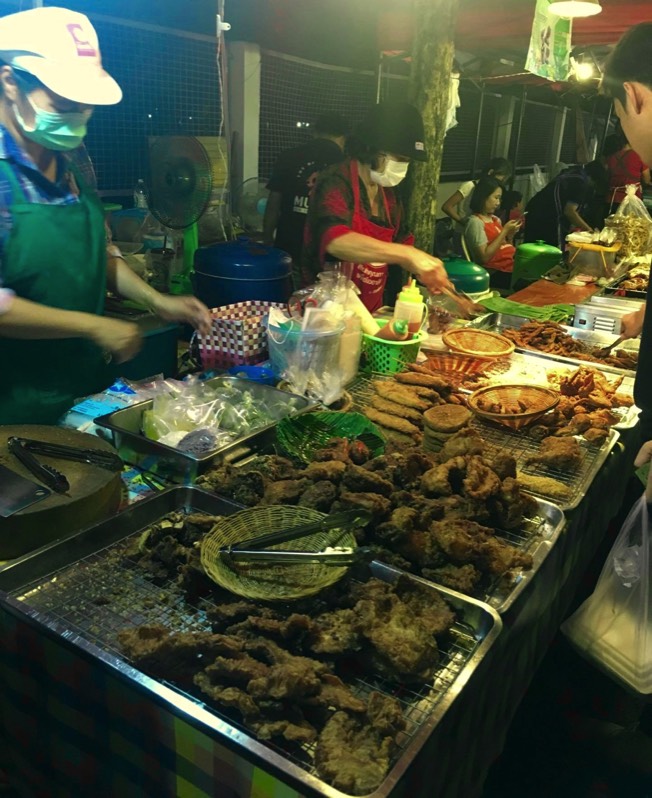
Street foods vendors outside Chiang Mai University gate. Photo: friend of author
Religion
Thailand is a predominantly Buddhist country. Religious freedom is constitutionally guaranteed and socially there is religious tolerance in Thailand. Though the Thai constitutions have guaranteed religious freedom while not explicitly mentioning Buddhism as the state religion, the Thai government tends to exalt, promote and protect Buddhism. All students are required to take Buddhism courses at school.
But it is noticeable that adherence to Buddhism, especially among the younger generations, is weakening and many young people only pay lip service to religion. Buddhism in Thailand faces the similar challenges as other institutions in the country. For the Buddhist establishment, it is not uncommon to read lurid tales of misbehavior by Buddhist monks in the Thai media. There have been reports of sexual assault, embezzlement, drug taking, and extravagant lifestyles, even murder. There are also considerable Muslims not only in Southern Thailand but also in other regions including Chiang Mai in the North. Christianity, Hinduism, Confucianism, Taoism and animism are other religions being practice in Thailand.
But it is noticeable that adherence to Buddhism, especially among the younger generations, is weakening and many young people only pay lip service to religion. Buddhism in Thailand faces the similar challenges as other institutions in the country. For the Buddhist establishment, it is not uncommon to read lurid tales of misbehavior by Buddhist monks in the Thai media. There have been reports of sexual assault, embezzlement, drug taking, and extravagant lifestyles, even murder. There are also considerable Muslims not only in Southern Thailand but also in other regions including Chiang Mai in the North. Christianity, Hinduism, Confucianism, Taoism and animism are other religions being practice in Thailand.
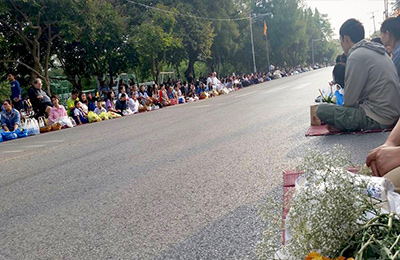
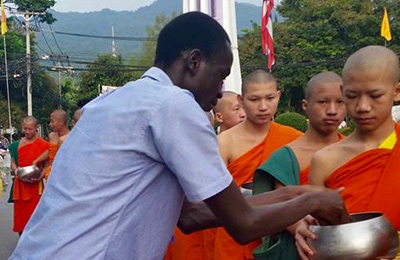
Left: People wait beside the road, Chiang Mai University, to offer donations to monks during a Buddhist festival. Right: the writer offering alms to Buddhist monks and novices
A Semester of Learning
To conclude this report, I would like to express my thanks to PAHSA for the chance to learn so much during my stay as a semester student at Chiang Mai University; it was a wonderful opportunity to explore this fascinating country. This short article attempts to report briefly on my observations on Thai politics and society during that time.
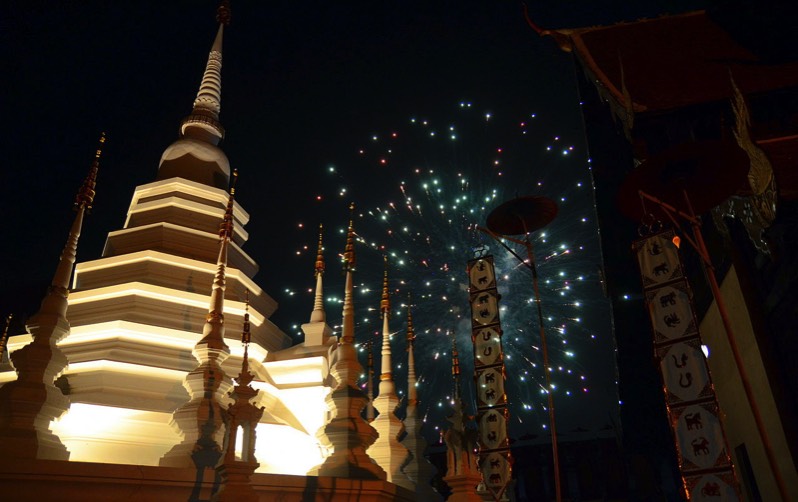
Fireworks above at Wat Phantao, Chiang Mai on the Sunday after the Loi Krathong festival. The fireworks were part of the extended Loi Krathong festivities in Chiang Mai. Photo: Wikimedia Commons
Notes—
For the corruption Index, see the 2015 Transparency International corruption Perception Index www.transparency.org/cpi2015 Accessed on 22.03.2016
For the HIV/AIDS Data on Thailand, see: http://www.unaids.org/en/regionscountries/countries/thailand. http://www.searo.who.int/thailand/areas/hivaids/en/ Accessed on 22. 03.2016.
For the Global Hunger Index, see: http://ghi.ifpri.org/trends/
For HDI, refer to UN 2014 Human Development Report. http://hdr.undp.org/en/data
Fukuyama, Francis( 2014),Political Order and Political Decay: From the Industrial Revolution to the Globalization of Democracy, Farrar, Straus an Giroux, New York.
Singapore’s Development: Education and Health Care Policies
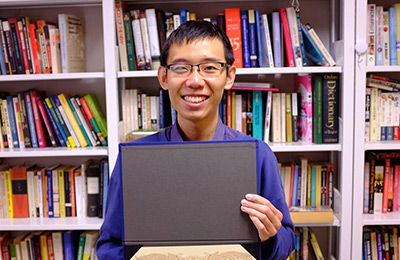
OSIPP, Osaka University
@ RSIS, Nanyang Technological University
Singapore
Thanks to the PAHSA program, I had the opportunity to travel from Japan and spend a semester at Singapore’s S. Rajarathnam School of International Studies, Nanyang Technological University. For most Japanese when they talk about Singapore, they are always fascinated by the rapid development of the City State. 50 years ago, Singapore was still a country in chaos. Yet today it is one of the most developed countries, and one with such a beautiful environment that it often referred to as the ‘garden city.’ From city construction and economic development, to measures to raise living standards of residents, Singapore has abundant experience for other countries to learn from. Effective policies as well as the systems established under these policies with respect to education and health care, two of the most fundamental services, have contributed significantly to the country’s growth.
Education
Huge investment in education and solid policies during the various stages of development helped Singapore achieve rapid progress. In international standardized tests for middle school students, Singaporean students’ average scores usually rank at or near the top. This performance reflects the education system’s effectiveness. In Singapore where there are few natural resources, the human resource is considered to be paramount. Under this central concept, the government regards education as its top priority and invests significantly in its development. In most years since 1980, the government’s expenditure on education accounts for more than 20% of its total expenditure with only more being spent on defense. Furthermore, its education policies were changed flexibly according with the country’s level of development. As a result, policies have been beneficial in improving the quality of education.
When industrial development was necessary, universal primary and lower secondary education was achieved from the mid-1960s to the 1970s. In the1980s when the efficiency of expenditure was emphasized, in order to enhance students’ performance, a “new education system” was put into operation in which three streams with different ways of progress were provided to students with varied abilities. Primary and secondary streaming was introduced as well: students had to take exams after completing their studies at a certain stage to determine which kind of schools or classes they be assigned. Although it might seem rigorous to some, with streaming exams as early as grade 3 in primary schools, students’ performance in several subjects such as mathematics and sciences became measurably better. Other factors have also had positive effect on Singaporean’s education. For example, similar to Japan, teachers of primary and secondary schools are public servants and this ensures them of stable employment. Teachers are provided with continuing training to upgrade their skills so that they might best cater for students’ changing needs. Additionally, technical and vocational education has also provides a large number of workers to industries. Generally speaking, education policies in different periods set the stage to provide the workforce for every point of Singapore’s development.
When industrial development was necessary, universal primary and lower secondary education was achieved from the mid-1960s to the 1970s. In the1980s when the efficiency of expenditure was emphasized, in order to enhance students’ performance, a “new education system” was put into operation in which three streams with different ways of progress were provided to students with varied abilities. Primary and secondary streaming was introduced as well: students had to take exams after completing their studies at a certain stage to determine which kind of schools or classes they be assigned. Although it might seem rigorous to some, with streaming exams as early as grade 3 in primary schools, students’ performance in several subjects such as mathematics and sciences became measurably better. Other factors have also had positive effect on Singaporean’s education. For example, similar to Japan, teachers of primary and secondary schools are public servants and this ensures them of stable employment. Teachers are provided with continuing training to upgrade their skills so that they might best cater for students’ changing needs. Additionally, technical and vocational education has also provides a large number of workers to industries. Generally speaking, education policies in different periods set the stage to provide the workforce for every point of Singapore’s development.
Health care
The health care system is well established in Singapore. But if you look at the statistical data, you may be surprised that the government only spends a relatively small proportion of money on health when compared to expenditure on education. The ratio of government’s expenditure on health care to GDP has been lower than 1.5% in most years since 1970. This is much lower than many other developed economies (for OECD members, the figure ranges from 3% to 9% in 2009), and the proportion of health care expenditure in the total government expenditure is lower than 7% from 1970 to the middle of the 2000s. This is largely due to the government’s pragmatism and its concept on health care which stresses “self-responsibility.”
Realizing that the rising costs of healthcare would become a huge burden on the government, Singapore decided to reform the financing and supply system of health care in the 1980s. A new “Medisave” account in which people could save a part of their salaries for health care purposes was established in their CPF (Central Provident Fund) accounts. With this reform, public hospitals became corporations affiliated to groups controlled by the government. The ‘restructuring’ that took place stimulated competition between hospitals and this raised the efficiency of the whole hospital system. At the same time, a healthy lifestyle was promoted and preventive health care advocated. These policies enable the government to maintain its health care expenditure at a low level while the residents’ health condition is maintained.
Another fact worth mentioning is that Singapore is a vibrant combination of various ethnic groups. Although people have roots and culture that may vary drastically from one to another, they live, and work together in relative harmony. Perhaps this fusion helps the country generate new ideas, which enables it to keep developing, and must surly set a good example for other multiracial countries. Until now, Singapore has made a great achievement in its economic and social development. As a young and vibrant country, it will surely continue growing and play an increasingly important role in the region.
Realizing that the rising costs of healthcare would become a huge burden on the government, Singapore decided to reform the financing and supply system of health care in the 1980s. A new “Medisave” account in which people could save a part of their salaries for health care purposes was established in their CPF (Central Provident Fund) accounts. With this reform, public hospitals became corporations affiliated to groups controlled by the government. The ‘restructuring’ that took place stimulated competition between hospitals and this raised the efficiency of the whole hospital system. At the same time, a healthy lifestyle was promoted and preventive health care advocated. These policies enable the government to maintain its health care expenditure at a low level while the residents’ health condition is maintained.
Another fact worth mentioning is that Singapore is a vibrant combination of various ethnic groups. Although people have roots and culture that may vary drastically from one to another, they live, and work together in relative harmony. Perhaps this fusion helps the country generate new ideas, which enables it to keep developing, and must surly set a good example for other multiracial countries. Until now, Singapore has made a great achievement in its economic and social development. As a young and vibrant country, it will surely continue growing and play an increasingly important role in the region.
Final thoughts
My time in Singapore offered the change to feel part of this small but dynamic nation. Coming from Japan there was much to learn and experience. So much about Singapore’s success rests on its ‘can-do’ attitude, and this is something that I hope will stay with me now that I am back in Japan. I feel very fortunate to have had this opportunity and would advise any student from Japan with the chance to spend a semester overseas just to ‘go for it!’
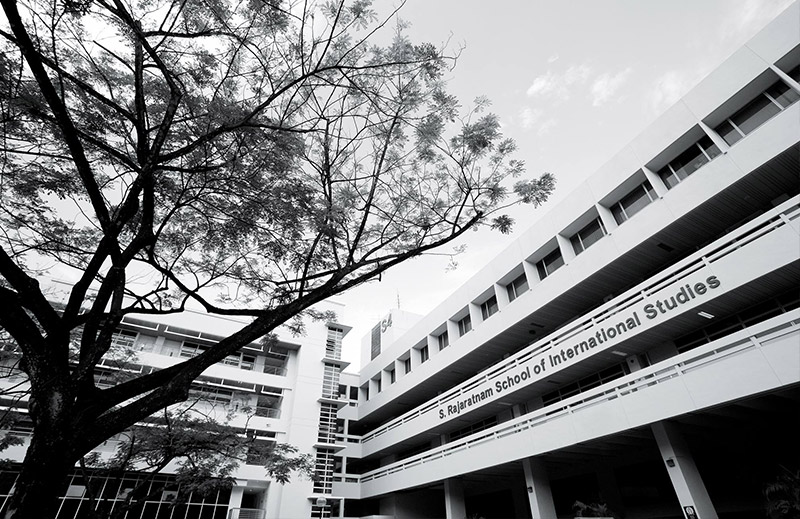
RSIS at the Nanyang Technological University campus in Singapore
Social Media’s Impact On Cambodia
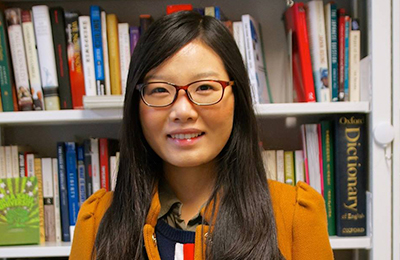
OSIPP, Osaka University
@ Pannasastra University of Cambodia
In August 2014, I had the good fortune to start a semester at the Pannasastra University of Cambodia as a PAHSA exchange student. This was perfect timing as I had become interested in social media and other digital technologies that offered citizens a platform for collective activism. During the 2011 Arab Spring uprisings, social media was widely credited as a vector to organize, raise awareness, and communicate in the face of states’ attempts to shut down avenues of communication. Given this, I was curious to find out about similar uses of social media in Southeast Asia, especially after it was reported that social media, Facebook particularly, had a key role in Cambodia’s 2013 elections.
At the 2013 Cambodian general elections, Prime Minister Hun Sen went to the polls to seek a further term. As Cambodian People’s Party’s (CPP) Deputy President, he had been the country’s premier for more than two decades. But this was to be a very different election to the previous poll in 2008 where he was returned with 58% of the popular vote and took 90 of 123 seats in the National Assembly. In the 2013 elections the Cambodian National Rescue Party (CNRP) would make big gains, and even though Hun Sen was returned to power, the margin of victory was much reduced (and this victory was questioned by Human Rights Watch with suggestions of irregularities). When the votes were tallied, the CPP lost 22 seats in the National Assembly, earning it the fewest percentage of seats since 1998. It is clear that the main opposition, the Cambodian National Rescue Party, was much more effective in its campaigning, and as it turned out, in its use of social media to appeal to more voters. New technologies were used to build traction, civic engagement, and empower greater involvement in the political process. But political engagement of this type does not sit well with the government. Since returning to power, there have been suggestions that the CPP sees social media as a “threat” and this has raised fears among free speech advocates that it is seeking to control the Internet in Cambodia by drafting cyber laws to limit freedoms of expression.
In Cambodia, like much of Southeast Asia, there has been increased Internet connectivity in recent years and mobile devices have become very popular among the younger generation. The information environment has expanded massively with this shift, and it has taken place in a country where media freedoms were traditionally curtailed. This has brought a rise in personal political blogs and ‘alternative’ news sites. Social media platforms have become an integral tool for the unfettered sharing of information and opinion. Young activists of both genders are using Facebook, Twitter, Instagram, and video sharing sites as platforms to disseminate opinions on important political and social issues. Online activists have taken to social media platforms to highlight issues such as corruption or land grabbing, topics that are off limits in the traditional press.
Cambodia’s traditional power holders see the rise of the new media as a “threat” to their power base. Before the 2013 elections, few believed the CNRP would challenge the long-dominant role of Hun Sen’s government; its stroll to victory was assumed to be straightforward. Yet the results of the 2013 elections came as a surprise to many. Outdated policies and a lackluster election campaign may have been a big reasons for the CPP setback, and during campaigning, messages about reconciliation, peace and economic development, the achievements of the CPP, rang hollow in the ears of voters. During Hun Sen’s long tenure, he presided over both impressive economic improvements for Cambodia as well as ever-worsening levels of corruption. For the first time, feelings of disenchantment were aired through social media channels, and with increased access to the Internet, this brought a much greater participation from young people in the political process. The Cambodian National Rescue Party was quick to capitalize on the new generation of social media users, and by doing so, the youth vote was galvanized in the direction of the CNRP.
The 2013 elections showed for Cambodia that the Internet was no longer on the fringes and it came to the fore in politics. Ordinary citizens were able to provide first-hand information, news updates and pictures, so to inform other members of the public. But following the 2013 elections, the Cambodian People’s Party set about drafting an anti-cybercrime bill to curtail these freedoms. It is thought that the bill, if passed, will contain provisions that could undermine freedoms of expression, and would create legal obstacles for those reporting on issues of public interest, or silence political activists seeking change from political leaders. Although recent reports have suggested that the anti-cybercrime bill may have been shelved for the time being, it is clear that some of those in power in Cambodia are aware that they need to try to control the Internet if they wish to go on dominating politically in the long-term.
Thanks to the PAHSA program, my semester of study in Cambodia offered me the opportunity to see how electoral democracy is maturing in this youthful nation. The country is now at a stage where voters are becoming more informed and social media has played a central role. It offers an avenue for personal empowerment, something that has been ignored in past elections. Certainly, I feel that 2013 poll was a turning point for building the democratic process in Cambodia. And one thing became abundantly clear during my stay: now that the Internet genie is out of the bottle, for Cambodia, online democracy will now be difficult to silence.
At the 2013 Cambodian general elections, Prime Minister Hun Sen went to the polls to seek a further term. As Cambodian People’s Party’s (CPP) Deputy President, he had been the country’s premier for more than two decades. But this was to be a very different election to the previous poll in 2008 where he was returned with 58% of the popular vote and took 90 of 123 seats in the National Assembly. In the 2013 elections the Cambodian National Rescue Party (CNRP) would make big gains, and even though Hun Sen was returned to power, the margin of victory was much reduced (and this victory was questioned by Human Rights Watch with suggestions of irregularities). When the votes were tallied, the CPP lost 22 seats in the National Assembly, earning it the fewest percentage of seats since 1998. It is clear that the main opposition, the Cambodian National Rescue Party, was much more effective in its campaigning, and as it turned out, in its use of social media to appeal to more voters. New technologies were used to build traction, civic engagement, and empower greater involvement in the political process. But political engagement of this type does not sit well with the government. Since returning to power, there have been suggestions that the CPP sees social media as a “threat” and this has raised fears among free speech advocates that it is seeking to control the Internet in Cambodia by drafting cyber laws to limit freedoms of expression.
In Cambodia, like much of Southeast Asia, there has been increased Internet connectivity in recent years and mobile devices have become very popular among the younger generation. The information environment has expanded massively with this shift, and it has taken place in a country where media freedoms were traditionally curtailed. This has brought a rise in personal political blogs and ‘alternative’ news sites. Social media platforms have become an integral tool for the unfettered sharing of information and opinion. Young activists of both genders are using Facebook, Twitter, Instagram, and video sharing sites as platforms to disseminate opinions on important political and social issues. Online activists have taken to social media platforms to highlight issues such as corruption or land grabbing, topics that are off limits in the traditional press.
Cambodia’s traditional power holders see the rise of the new media as a “threat” to their power base. Before the 2013 elections, few believed the CNRP would challenge the long-dominant role of Hun Sen’s government; its stroll to victory was assumed to be straightforward. Yet the results of the 2013 elections came as a surprise to many. Outdated policies and a lackluster election campaign may have been a big reasons for the CPP setback, and during campaigning, messages about reconciliation, peace and economic development, the achievements of the CPP, rang hollow in the ears of voters. During Hun Sen’s long tenure, he presided over both impressive economic improvements for Cambodia as well as ever-worsening levels of corruption. For the first time, feelings of disenchantment were aired through social media channels, and with increased access to the Internet, this brought a much greater participation from young people in the political process. The Cambodian National Rescue Party was quick to capitalize on the new generation of social media users, and by doing so, the youth vote was galvanized in the direction of the CNRP.
The 2013 elections showed for Cambodia that the Internet was no longer on the fringes and it came to the fore in politics. Ordinary citizens were able to provide first-hand information, news updates and pictures, so to inform other members of the public. But following the 2013 elections, the Cambodian People’s Party set about drafting an anti-cybercrime bill to curtail these freedoms. It is thought that the bill, if passed, will contain provisions that could undermine freedoms of expression, and would create legal obstacles for those reporting on issues of public interest, or silence political activists seeking change from political leaders. Although recent reports have suggested that the anti-cybercrime bill may have been shelved for the time being, it is clear that some of those in power in Cambodia are aware that they need to try to control the Internet if they wish to go on dominating politically in the long-term.
Thanks to the PAHSA program, my semester of study in Cambodia offered me the opportunity to see how electoral democracy is maturing in this youthful nation. The country is now at a stage where voters are becoming more informed and social media has played a central role. It offers an avenue for personal empowerment, something that has been ignored in past elections. Certainly, I feel that 2013 poll was a turning point for building the democratic process in Cambodia. And one thing became abundantly clear during my stay: now that the Internet genie is out of the bottle, for Cambodia, online democracy will now be difficult to silence.
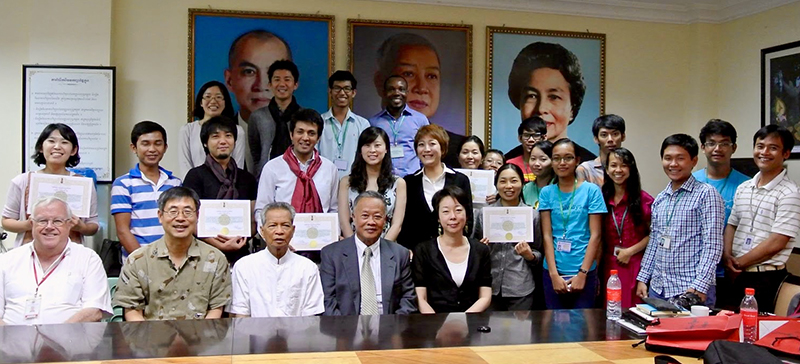
Students from Japan at the Pannasastra University of Cambodia (PUC) for the one-week short-term study program, 7-16 March 2013. Read essays from the the students on the program here.
The conflict in East Timor: Youth Activism and Independence
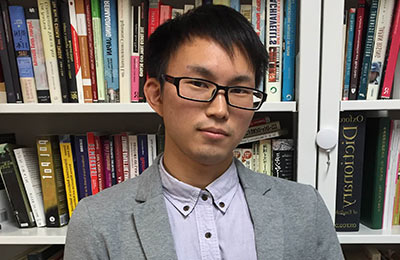
OSIPP, Osaka University
@ National University of East Timor
East Timor gained self-rule in 2002 after 1999’s referendum poll where the majority of the people, 78.5% of the valid votes cast, voted for independence. When Indonesia invaded in 1975 following a previous declaration of independence, this tiny country, which at the time had less than 700,000 people, would suffer greatly. Indonesia’s occupation was marked with violence and brutality. The subsequent 24-year independence struggle helped shape the East Timorese attitudes that we see today. Thus it is necessary to look at the past in order to understand the current political situation of East Timor, and more specifically, the ongoing challenges of a post-conflict state.
Despite 15 years having passed since the end of the conflict, the mood of that time is still felt in parts of the country. But even with the turbulent history, a calm prevails, and people are welcoming and open-minded; it is difficult to imagine that many of these people had once been activists. As an outsider, it seems that East Timor is a country worthy of peace, and I was fortunate to study for six months and do my research there. But the truth of the past cannot be undone and my aim was to unravel part of the Timorese struggle and frame this in the context of the Timorese youth.
East Timor’s youth, or the “new generation” contributed to the independence campaign in a different style to the their elders who took on the more traditional role of freedom fighters. Instead, the youth movement largely acted in a non-violent manner. It is also worth mentioning here that there were parallels between the East Timorese struggle and the Indonesian pro-democracy movement. Although the East Timorese independence struggle and efforts for democracy in Indonesia are quite different matters, it is also important to understand East Timor’s struggle in the Indonesia’s context. The East Timorese struggle offered impetus for Indonesian activists whose efforts had been quelled by the military regime, and who went on to conduct intense demonstrations in the 1990s. My research is about how the East Timorese activists endeavored in their efforts to solve the conflict peacefully. My aim is to analyze the strife from a domestic point of view rather than capture the whole picture on a larger scale. For me, studying discord should start from understanding the basic realities of conflict, people-to-people interaction, and I hope my observation and analysis will contribute, in a small part, to the literature of conflict studies and international relations.
Despite 15 years having passed since the end of the conflict, the mood of that time is still felt in parts of the country. But even with the turbulent history, a calm prevails, and people are welcoming and open-minded; it is difficult to imagine that many of these people had once been activists. As an outsider, it seems that East Timor is a country worthy of peace, and I was fortunate to study for six months and do my research there. But the truth of the past cannot be undone and my aim was to unravel part of the Timorese struggle and frame this in the context of the Timorese youth.
East Timor’s youth, or the “new generation” contributed to the independence campaign in a different style to the their elders who took on the more traditional role of freedom fighters. Instead, the youth movement largely acted in a non-violent manner. It is also worth mentioning here that there were parallels between the East Timorese struggle and the Indonesian pro-democracy movement. Although the East Timorese independence struggle and efforts for democracy in Indonesia are quite different matters, it is also important to understand East Timor’s struggle in the Indonesia’s context. The East Timorese struggle offered impetus for Indonesian activists whose efforts had been quelled by the military regime, and who went on to conduct intense demonstrations in the 1990s. My research is about how the East Timorese activists endeavored in their efforts to solve the conflict peacefully. My aim is to analyze the strife from a domestic point of view rather than capture the whole picture on a larger scale. For me, studying discord should start from understanding the basic realities of conflict, people-to-people interaction, and I hope my observation and analysis will contribute, in a small part, to the literature of conflict studies and international relations.
Roots of the conflict
East Timor was colonized by Portugal in the sixteenth century. Even though moves were afoot to liberate many of Europe’s African colonies in the 1960s, a time when the world was locked in cold war politics, Portugal's colonies including East Timor remained under colonial rule until the mid 1970s. Changes were brought about in 1974 when the Carnation Revolution, a military coup in Lisbon, Portugal, proved to be huge turning point. For many of the colonies, this wave offered a path to democratization. But Portugal's official position is that they did not withdraw from East Timor, and that position was supported at the UN in the sense that Portugal was recognized as the Administering Power of East Timor until 1999. But as the wave of freedoms was felt in the 1970s, East Timor pitched and rolled violently before finally declaring independence from colonial rule in November 1975. Things became much darker when Indonesia, fearing the rise of a communist state in the Indonesian archipelago, invaded the country in December 1975.
Throughout the history of the struggle that followed, the early 1990s was the most tumultuous for the Timorese, and on the world stage too, there were huge changes internationally when the Soviet Union crumbled in 1991. The same year also saw the Santa Crus Massacre where about 200 East Timorese pro-independence demonstrators were gunned down in the Santa Cruz cemetery. It became a turning point for the independence cause internationally as solidarity movements grew in Indonesia and elsewhere. All this took place under the oppressively authoritarian Suharto regime in Indonesia. International society, especially powerful states, began to pay attention to the abuses taking place in East Timor.
Timorese youth campaigners were active during the decade, and at the same time, active opposition to the Indonesian government was growing in Indonesia itself. Pro-democracy movements, both from East Timor and Indonesia linked up. This was made easier by a policy offering Timorese students the opportunity to study in Indonesia. The students’ slogan was “Democracy for Indonesia and Independence for East Timor.” Looking back, it might seem strange that young Indonesian and East Timorese activists were to cooperate in showing the people of Indonesia the reality of the horrors taking place in East Timor. But at the time, many people felt the heavy hand of Suharto, and it was important for the story of the atrocities in East Timor to be told.
Throughout the history of the struggle that followed, the early 1990s was the most tumultuous for the Timorese, and on the world stage too, there were huge changes internationally when the Soviet Union crumbled in 1991. The same year also saw the Santa Crus Massacre where about 200 East Timorese pro-independence demonstrators were gunned down in the Santa Cruz cemetery. It became a turning point for the independence cause internationally as solidarity movements grew in Indonesia and elsewhere. All this took place under the oppressively authoritarian Suharto regime in Indonesia. International society, especially powerful states, began to pay attention to the abuses taking place in East Timor.
Timorese youth campaigners were active during the decade, and at the same time, active opposition to the Indonesian government was growing in Indonesia itself. Pro-democracy movements, both from East Timor and Indonesia linked up. This was made easier by a policy offering Timorese students the opportunity to study in Indonesia. The students’ slogan was “Democracy for Indonesia and Independence for East Timor.” Looking back, it might seem strange that young Indonesian and East Timorese activists were to cooperate in showing the people of Indonesia the reality of the horrors taking place in East Timor. But at the time, many people felt the heavy hand of Suharto, and it was important for the story of the atrocities in East Timor to be told.
Turning Point: The Santa Cruz Massacre
The savage violence by Indonesian military in 1991 at the Santa Cruz Massacre ironically changed not only the situation of East Timor but partially that of Indonesia. What took place was the first mass killing from East Timor to be broadcast by the international media. Footage of the indiscriminate violence was smuggled out and caused outrage around the world as people became aware of the East Timor conflict and the savage brutality meted out by the Indonesia’s military. Demonstrations intensified in both East Timor and Indonesia. Indonesian pro-democracy activist, Rachland Nashidik, believes that the Santa Cruz Massacre had a huge impact on Indonesian society as well as East Timor itself. It opened up a space for Indonesians to demonstrate on the street because Indonesian youths were also suppressed by the military regime. After the massacre, dissenting voices found their stage; suddenly the movement for change picked up momentum.
In reality however, clear opportunities to broaden the relations between the young Timorese and Indonesian activists were somewhat limited. At the time, the media was tightly controlled, and those were the days before the ubiquitous social media that we all know today. Among activists most acutely attuned to the realities in East Timor were members of radical pro-democracy groups, and they had their own tight networks for the dissemination of information. Yet at the same time, it is worth mentioning that those activists were the actors striving for the betterment of society; they had the will to build a more democratic and peaceful Indonesia. A referendum for East Timor was the goal, and it was needed not only to guarantee democracy for the Timorese, but also to spur egalitarianism on the Indonesian side, critical if the country was to truly become a modern democratic nation.
In reality however, clear opportunities to broaden the relations between the young Timorese and Indonesian activists were somewhat limited. At the time, the media was tightly controlled, and those were the days before the ubiquitous social media that we all know today. Among activists most acutely attuned to the realities in East Timor were members of radical pro-democracy groups, and they had their own tight networks for the dissemination of information. Yet at the same time, it is worth mentioning that those activists were the actors striving for the betterment of society; they had the will to build a more democratic and peaceful Indonesia. A referendum for East Timor was the goal, and it was needed not only to guarantee democracy for the Timorese, but also to spur egalitarianism on the Indonesian side, critical if the country was to truly become a modern democratic nation.
Conclusion
These are some of my brief observations after my study in East Timor. Of course there is much more to say, and as my research is still on going, there is still much more to find out, especially documentary research in Indonesia to examine how young Indonesians saw the conflict unfold in East Timor. However, my six months in East Timor and Indonesia gave me the opportunity to truly feel the mood of the people and taste their enthusiasm to build a nation. And it also allowed me to tap into what the activists were feeling in the 1990s, their memories are still vivid. Without doubt, East Timor is now at a turning point, and I consider myself enormously privileged to have spent time in this wonderful country at this important time.
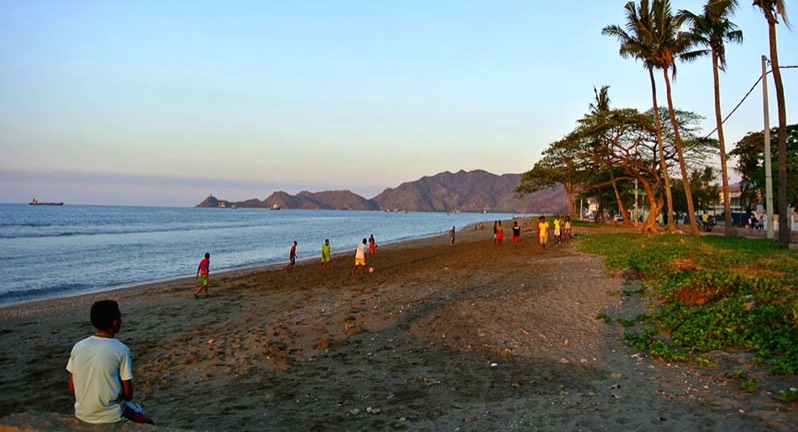
Today’s youths of East Timor letting of steam over a game of football on the beach (September 2014)
Getting a feel for the youngest nation in Asia
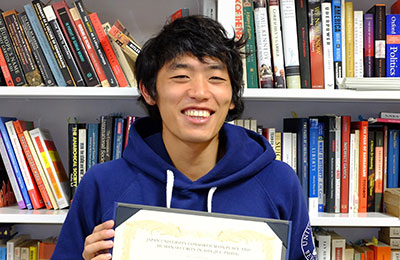
OSIPP, Osaka University
@ National University of East Timor
Thanks to the PAHSA program, I was fortunate to have had the opportunity to study in East Timor for six months. Although it was a relatively short time, from the start I hit the ground running and dedicated myself to research on the country's land politics. In this essay I would like to share my feeling on this exciting country and offer some thoughts on conducting research during my time there.
When I set out on my study program in East Timor, unwittingly, I had with me the mindset that had been shaped by my upbringing in Japan. I assumed the country would share the same neoliberal market-based systems that seem ubiquitous in much of the world, including my home country. The clear differences were jarring at first, and particularly so at the National University of East Timor. At the University, professors called attention to socialist theorists such as Marx, Lenin, Gramsci and Mao in their lectures. Often, their reservations of the laissez-faire economic system were plain to see. I was confused by this at first, but then realized the professors were shaped by the society, East Timor, and it was a place with which I still had a great deal to learn. And similarly, in my first months collecting reports and data issued by NGOs for my research, in their submissions NGOs would often make sweeping recommendations, like the government should distribute land and limit this to a hectare per-person. These kinds of policy recommendations often struck me as odd, progressively leftist and almost radical at times; these too were difficult for me to comprehend. However, it then struck me that I was still seeing Timorese society through Japanese eyes. From that day I tried to step out of myself and understand the Timorese from their perspective. Before going to East Timor I was told of the importance of trying to understand the thinking of the country. But I didn't fully grasp that until spending time there.
More aware of differing moods and attitudes to my own, I gradually acquired the picture of land politics in East Timor and this led to a crucial step in my research. The contextual backgrounds of the NGOs became more meaningful; it was also a window to understand the government stance on draft land laws when juxtaposed against civil society demands. Reading works about East Timor while in Japan, I could easily miss an important background factor for my research, the sentiment of the people. If a textbook mentions socialist aspects of Timorese society, I would not have been able to comprehend the complexities of feelings attached to those. Only by being in East Timor could a true understanding develop, and perhaps this was the most interesting experience.
During my six months in East Timor, I visited local NGOs, administrative offices, the Parliament, and met a lot of Timorese and Japanese people. The locals are very hospitable and helped my research tremendously. For example, when I asked for interviews with NGO staff, they would always spare their time, answer my questions, and go out of their way to offer additional information and valuable materials for my research. I also made friends with many Japanese that are working with the Japan International Cooperation Agency (JICA), the Ministry of Foreign Affairs, as well as other NGOs. It was very interesting to talk with them and learn their stories.
Six months passed more quickly than I would have guessed, but I can say unequivocally that they were fulfilling months. I enjoyed my research and the homestay with a Timorese family. Beautiful smiles, the wonderful sea, tasty coffee, dusty roads, noisy all night music, blackouts, clunker taxies ... these all mix to become part of the soul of the young nation. It was truly a great experience. The Timorese still have many challenging problems to overcome, but I'm sure they will find their own way; the spirit of the nation will guide them.
When I set out on my study program in East Timor, unwittingly, I had with me the mindset that had been shaped by my upbringing in Japan. I assumed the country would share the same neoliberal market-based systems that seem ubiquitous in much of the world, including my home country. The clear differences were jarring at first, and particularly so at the National University of East Timor. At the University, professors called attention to socialist theorists such as Marx, Lenin, Gramsci and Mao in their lectures. Often, their reservations of the laissez-faire economic system were plain to see. I was confused by this at first, but then realized the professors were shaped by the society, East Timor, and it was a place with which I still had a great deal to learn. And similarly, in my first months collecting reports and data issued by NGOs for my research, in their submissions NGOs would often make sweeping recommendations, like the government should distribute land and limit this to a hectare per-person. These kinds of policy recommendations often struck me as odd, progressively leftist and almost radical at times; these too were difficult for me to comprehend. However, it then struck me that I was still seeing Timorese society through Japanese eyes. From that day I tried to step out of myself and understand the Timorese from their perspective. Before going to East Timor I was told of the importance of trying to understand the thinking of the country. But I didn't fully grasp that until spending time there.
More aware of differing moods and attitudes to my own, I gradually acquired the picture of land politics in East Timor and this led to a crucial step in my research. The contextual backgrounds of the NGOs became more meaningful; it was also a window to understand the government stance on draft land laws when juxtaposed against civil society demands. Reading works about East Timor while in Japan, I could easily miss an important background factor for my research, the sentiment of the people. If a textbook mentions socialist aspects of Timorese society, I would not have been able to comprehend the complexities of feelings attached to those. Only by being in East Timor could a true understanding develop, and perhaps this was the most interesting experience.
During my six months in East Timor, I visited local NGOs, administrative offices, the Parliament, and met a lot of Timorese and Japanese people. The locals are very hospitable and helped my research tremendously. For example, when I asked for interviews with NGO staff, they would always spare their time, answer my questions, and go out of their way to offer additional information and valuable materials for my research. I also made friends with many Japanese that are working with the Japan International Cooperation Agency (JICA), the Ministry of Foreign Affairs, as well as other NGOs. It was very interesting to talk with them and learn their stories.
Six months passed more quickly than I would have guessed, but I can say unequivocally that they were fulfilling months. I enjoyed my research and the homestay with a Timorese family. Beautiful smiles, the wonderful sea, tasty coffee, dusty roads, noisy all night music, blackouts, clunker taxies ... these all mix to become part of the soul of the young nation. It was truly a great experience. The Timorese still have many challenging problems to overcome, but I'm sure they will find their own way; the spirit of the nation will guide them.
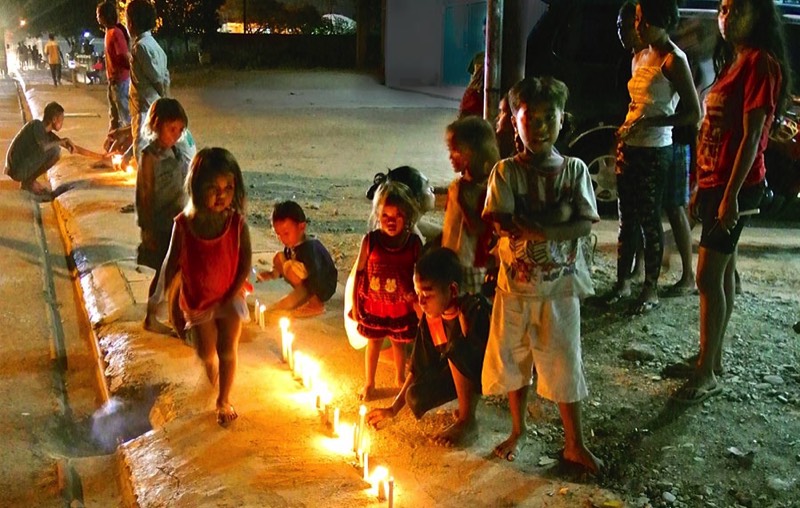
East Tmor: The young nation has a vibrant soul
Living and studying in Aceh: Bringing understanding to the world around us
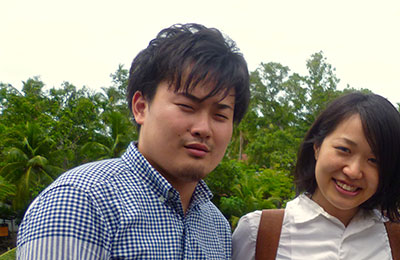
OSIPP, Osaka University
@ Syiah Kuala University
As a student on the PAHSA program, I was fortunate to have the opportunity to study for a semester at Syiah Kuala University, Banda Aceh, Indonesia. Below are some of my observations following the experience of living and studying in another culture, as well as some of the things with which I am left to ponder in the future.
It has been some years since Aceh has featured as top news. Cruelly devastated by the Indian Ocean tsunami in December 2004, before that, Aceh lived through a 30-year, sometimes-violent struggle for independence from Indonesia. More recently, since the start of the peace negotiations, which culminated in the signing of the Peace Agreement in August 2005, the region has been experiencing a process of calm. On the one hand there has been healing, rebuilding, and most recently, vibrant regeneration. But on the other hand, there is murmur of dissenting voices as critics of “contemporary Aceh” are speaking out in disapproving tones. For them, Aceh is not living up to the promise of pre-independence dreams. Yet in order to try to understand Aceh today, we have to look back to the past.
The conflict between Indonesian military forces and the Aceh-based paramilitary guerilla organization, Gerakan Aceh Merdeka or GAM, lasted between 1976 and 2002. GAM saw three incarnations as its cry for Aceh’s Independence grew ever more strident with the growing resentment over the perceived mistreatment from the Javanese-dominated Indonesian government, disagreements over Islamic law, and unhappiness over the distribution of the wealth that was being generated in the resource-rich region. During the conflict, it is thought that many thousands lost their lives as violence from both sides became desperate and the hostility between the government and rebels ever more entrenched. But in the aftermath of the massive tsunami that struck the region in December 2004, GAM called a ceasefire and this provided a window for peace negotiations to be considered. Ultimately, these came to fruition and calls for violence was finally put to rest with the 2005 Peace Agreement.
Although Aceh is now a very different place to that of the pre-tsunami era, people are still coming to grips with what took place in the past—both in terms of the years-long violent struggle and the tsunami devastation. The conflict is still in the minds of the people and deep wounds have been left behind. In an headfirst rush towards development, it is important that the reasons the conflict took place should not be forgotten. Mindfulness of the past can provide a foundation for the guiding principles of a ‘contemporary Aceh.’
One of the factors behind the conflict was the discontent over the distribution of resources by the Indonesian government and the feeling that corrupt Indonesian officials were growing fat with graft at the expense of the Acehnese. Many countries in Southeast Asia have ‘issues’ with corruption and there are signs of ‘inequalities’ of many kinds in Aceh just as elsewhere in the region. In Aceh today, many GAM-affiliated officials are playing a supervisory role in the administration of the region and this is disquieting to some. During the struggles, there were reports that GAM’s tactics were heavy-handed and sometimes extortion took place. Now, GAM-affiliated officials have their hands on the reins of power as well as the purse strings. For some Acehnese this is frustrating and the talk of ‘corruption’ hangs over the administration. As someone living and studying with the local people, I noted that the true meaning of ‘Justice in Aceh’ and the lessons from the past should not be forgotten as the region strives to move forward. Yet positively, at Aceh’s Syiah Kuala University today, there are many students studying politics and economics. Studying these subjects might help bring focus while they evaluate what is happening around them. The Acehnese students are talking about issues of corruption openly and constructively, and this surely bodes well for the future as the ‘nuts-and-bolts’ of society is starting to be scrutinized by the younger generation.
As a Japanese student growing up and attending university in my homeland, it was an interesting experience studying International Human Rights Law in an Islamic society in Aceh, which is 90 percent Muslim. Many of the issues that are taken as a given in Japan—for instance, certain freedoms of expression or opinions on certain religious principles—needed to be recast in the thinkings of a different society. Though this process I learned that it is necessary to be always mindful of differences, how the ways, values, ethics and ideology may not be the same as those of one’s own country or society, and that understanding these differences make us richer individuals and the world a more tolerant place.
Of course, differences may be understood through reading the literature, but coming into contact directly also makes things somehow more tangible. For many Japanese religion is not a major factor that shapes their lives or reality, yet this is not so in the Islamic world. While living in Aceh I began to understand other perspectives, learned much about the importance of respecting homogeneity as well as heterogeneity in others. Direct experience of such things is difficult to get from a classroom lecture surrounded by one’s own countrymen with similar values therefore I can honestly say that I felt the true significance of studying abroad.
In Japan, my study was all about reading, thinking, listening carefully and staying focused. In Aceh there was something else too: ‘Experience.’ I could experience how human beings are similar and different at the same time, and although these might seem contradictory somewhat while studying in Japan, living and learning with the people of Aceh helped me understand more deeply, and this will motivate me in my future research topic: conflict and coexistence in the Middle East.
It has been some years since Aceh has featured as top news. Cruelly devastated by the Indian Ocean tsunami in December 2004, before that, Aceh lived through a 30-year, sometimes-violent struggle for independence from Indonesia. More recently, since the start of the peace negotiations, which culminated in the signing of the Peace Agreement in August 2005, the region has been experiencing a process of calm. On the one hand there has been healing, rebuilding, and most recently, vibrant regeneration. But on the other hand, there is murmur of dissenting voices as critics of “contemporary Aceh” are speaking out in disapproving tones. For them, Aceh is not living up to the promise of pre-independence dreams. Yet in order to try to understand Aceh today, we have to look back to the past.
The conflict between Indonesian military forces and the Aceh-based paramilitary guerilla organization, Gerakan Aceh Merdeka or GAM, lasted between 1976 and 2002. GAM saw three incarnations as its cry for Aceh’s Independence grew ever more strident with the growing resentment over the perceived mistreatment from the Javanese-dominated Indonesian government, disagreements over Islamic law, and unhappiness over the distribution of the wealth that was being generated in the resource-rich region. During the conflict, it is thought that many thousands lost their lives as violence from both sides became desperate and the hostility between the government and rebels ever more entrenched. But in the aftermath of the massive tsunami that struck the region in December 2004, GAM called a ceasefire and this provided a window for peace negotiations to be considered. Ultimately, these came to fruition and calls for violence was finally put to rest with the 2005 Peace Agreement.
Although Aceh is now a very different place to that of the pre-tsunami era, people are still coming to grips with what took place in the past—both in terms of the years-long violent struggle and the tsunami devastation. The conflict is still in the minds of the people and deep wounds have been left behind. In an headfirst rush towards development, it is important that the reasons the conflict took place should not be forgotten. Mindfulness of the past can provide a foundation for the guiding principles of a ‘contemporary Aceh.’
One of the factors behind the conflict was the discontent over the distribution of resources by the Indonesian government and the feeling that corrupt Indonesian officials were growing fat with graft at the expense of the Acehnese. Many countries in Southeast Asia have ‘issues’ with corruption and there are signs of ‘inequalities’ of many kinds in Aceh just as elsewhere in the region. In Aceh today, many GAM-affiliated officials are playing a supervisory role in the administration of the region and this is disquieting to some. During the struggles, there were reports that GAM’s tactics were heavy-handed and sometimes extortion took place. Now, GAM-affiliated officials have their hands on the reins of power as well as the purse strings. For some Acehnese this is frustrating and the talk of ‘corruption’ hangs over the administration. As someone living and studying with the local people, I noted that the true meaning of ‘Justice in Aceh’ and the lessons from the past should not be forgotten as the region strives to move forward. Yet positively, at Aceh’s Syiah Kuala University today, there are many students studying politics and economics. Studying these subjects might help bring focus while they evaluate what is happening around them. The Acehnese students are talking about issues of corruption openly and constructively, and this surely bodes well for the future as the ‘nuts-and-bolts’ of society is starting to be scrutinized by the younger generation.
As a Japanese student growing up and attending university in my homeland, it was an interesting experience studying International Human Rights Law in an Islamic society in Aceh, which is 90 percent Muslim. Many of the issues that are taken as a given in Japan—for instance, certain freedoms of expression or opinions on certain religious principles—needed to be recast in the thinkings of a different society. Though this process I learned that it is necessary to be always mindful of differences, how the ways, values, ethics and ideology may not be the same as those of one’s own country or society, and that understanding these differences make us richer individuals and the world a more tolerant place.
Of course, differences may be understood through reading the literature, but coming into contact directly also makes things somehow more tangible. For many Japanese religion is not a major factor that shapes their lives or reality, yet this is not so in the Islamic world. While living in Aceh I began to understand other perspectives, learned much about the importance of respecting homogeneity as well as heterogeneity in others. Direct experience of such things is difficult to get from a classroom lecture surrounded by one’s own countrymen with similar values therefore I can honestly say that I felt the true significance of studying abroad.
In Japan, my study was all about reading, thinking, listening carefully and staying focused. In Aceh there was something else too: ‘Experience.’ I could experience how human beings are similar and different at the same time, and although these might seem contradictory somewhat while studying in Japan, living and learning with the people of Aceh helped me understand more deeply, and this will motivate me in my future research topic: conflict and coexistence in the Middle East.
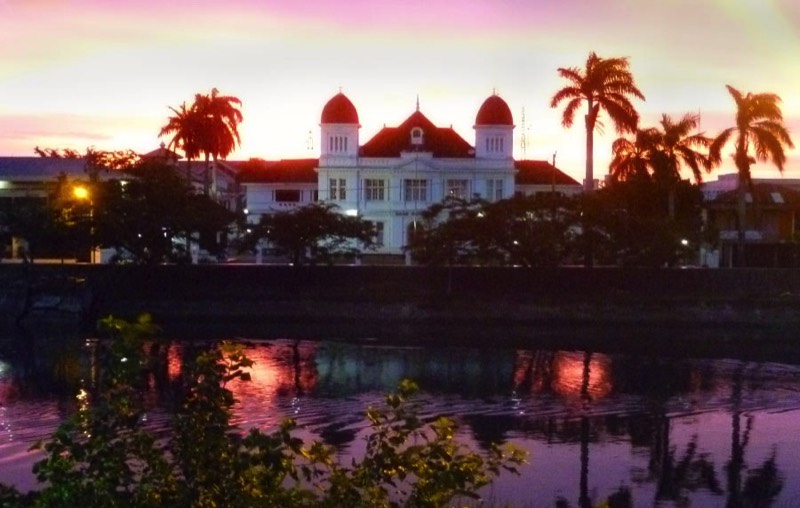
"Study in Aceh is about something else too: Experience"
Buddhism’s impact on Thailand
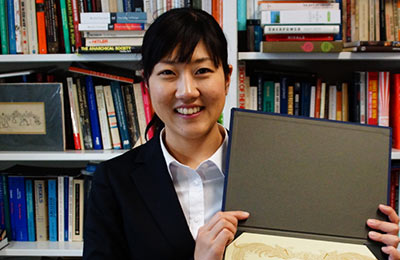
OSIPP, Osaka University
@ Chiang Mai University
Buddhism is the state religion of Thailand. Under the Constitution, as a symbol of the nation, the King must be a Buddhist although he is a protector of all religions. According to the 2010 census, the country has a population of over 65 million, and of these, approximately 94 percent are Buddhists. Not surprisingly, Buddhism has had a deep influence on Thai arts, education, family traditions (such as a short time as a novice monk for many young males), and the character of the people. In short, the close relationship between Buddhism and the Thais is an integral part of the Thailand we know today.
The Thai nation has historical roots dating back over 2,000 years. Thoughout that period, Buddhism became institutionalized (Phra Dhammapitaka 2002) as the legitimacy of the state and the Buddhist kingship grew ties with Buddhist institutions. While countries around Thailand were colonized by European powers, only Thailand managed to remain independent. This was thanks to the deft footwork of King Chulalongkorn (1868-1910), considered by most Thais to be one of the greatest kings of Siam (the former name of Thailand). Chulalongkorn, a devout Buddhist, not only fended off Western expansionism, but his zeal for modernization led to immense government and social reforms and his blueprint is the basis of today’s Thailand. For this reason, Thais revere Chulalongkorn as The Great Beloved King.
Thai Buddhism, largely of the Theravada school (one of the oldest surviving branched of Buddhism), is different to the more familiar version of the religion at home. In Japan, Buddhism is aligned to other schools and in addition, followers are often aligned to Shinto (the indigenous spirituality of Japan) as neither religions demand exclusivity. Consequently, there are many differences to be found.
In Japan, there seems to be a disconnect between Buddhism and everyday life and it is possible to lead a life that feels untouched by the religion if one is not particularly pious. This could never be said about Thailand where Buddhist symbolism is omnipresent in the streets, workplace, shopping centers, and even bars and taxis. I learned a lot about Buddhism in Thailand. During my stay in Chiang Mai, I had a chance to chat with some monks near a temple; it was impressive that one monk was just a seventeen years-old novice, but he was independent in his thinking, and emanated peace and satisfaction with life in the monkhood. I could not fail to respect his commitment.
Thai society is very tolerant, and here too, Buddhism’s influence is felt. Although the Buddhist Teachings (the Sangha) maintains a very reserved attitude to social issues in general, the approach is non-judgemental and this is reflected in the attitudes of the Thais. Transgender people are openly accepted for example. Yonlada Suanyos, a transgender woman, has defeated two other male candidates to become a member of provincial council in the Nan province of northern Thailand thereby becoming the first openly transgender person to hold public office in the country (Admin 2012). I cannot imagine this taking place in conservative Japan. With open attitudes and this level of frankness, it feels Japan is less developed and could learn much from Thai culture.
While spending a semester in Chiang Mai, there is a palpable feeling that Buddhism is close to everyone’s lives; it is woven into the fabric of the community. People visit temples regularly for worship or to seek the counseling of monks. Often people just step inside temple compounds to take a break from life, to sit and contemplate. Monks go on their alms rounds every morning and people are always lined up ready to offer whatever they can. The Five Precepts of Buddhism; abstaining form harming living beings, theft, sexual misconduct, lying, and intoxication, are not always closely followed by ordinary people, yet they are still a guiding influence nevertheless. Ever pragmatic, the Thais believe that if they break these Precepts, somewhere down the road there will be a price to pay.
Many of Thailand’s tourist spots are related to Buddhism. The glittering temple compounds and saffron-robed monks offer a wonderfully scenic background for holidaymakers. These bring big economic benefits and in many areas, tourism is a mainstay for the economy.
But although Buddhism contributed to the modernization and prosperity in Thailand, some of its influence on the characteristics of the people might hold back the country in today’s fast-paced world. The nature of the people, and perhaps society as a whole, is easy-going, deeply superstitious, and seems to lack a competitive drive; these are not the best perspectives when an economy hits the buffers or there are social issues to tackle. Japanese life is very busy, at times stressful, and so strict, seemingly lacking the freedoms so evident when one looks around Thailand. I suppose Thailand and Japan could each take some good points from the other’s culture, systems and attitudes. In this way, we could learn much from each other. - See more at: http://peace-hs.osipp.osaka-u.ac.jp/PAHSA_writing_semester_SE_ASIA.html#sthash.IN0Gg8zV.dpuf
The Thai nation has historical roots dating back over 2,000 years. Thoughout that period, Buddhism became institutionalized (Phra Dhammapitaka 2002) as the legitimacy of the state and the Buddhist kingship grew ties with Buddhist institutions. While countries around Thailand were colonized by European powers, only Thailand managed to remain independent. This was thanks to the deft footwork of King Chulalongkorn (1868-1910), considered by most Thais to be one of the greatest kings of Siam (the former name of Thailand). Chulalongkorn, a devout Buddhist, not only fended off Western expansionism, but his zeal for modernization led to immense government and social reforms and his blueprint is the basis of today’s Thailand. For this reason, Thais revere Chulalongkorn as The Great Beloved King.
Thai Buddhism, largely of the Theravada school (one of the oldest surviving branched of Buddhism), is different to the more familiar version of the religion at home. In Japan, Buddhism is aligned to other schools and in addition, followers are often aligned to Shinto (the indigenous spirituality of Japan) as neither religions demand exclusivity. Consequently, there are many differences to be found.
In Japan, there seems to be a disconnect between Buddhism and everyday life and it is possible to lead a life that feels untouched by the religion if one is not particularly pious. This could never be said about Thailand where Buddhist symbolism is omnipresent in the streets, workplace, shopping centers, and even bars and taxis. I learned a lot about Buddhism in Thailand. During my stay in Chiang Mai, I had a chance to chat with some monks near a temple; it was impressive that one monk was just a seventeen years-old novice, but he was independent in his thinking, and emanated peace and satisfaction with life in the monkhood. I could not fail to respect his commitment.
Thai society is very tolerant, and here too, Buddhism’s influence is felt. Although the Buddhist Teachings (the Sangha) maintains a very reserved attitude to social issues in general, the approach is non-judgemental and this is reflected in the attitudes of the Thais. Transgender people are openly accepted for example. Yonlada Suanyos, a transgender woman, has defeated two other male candidates to become a member of provincial council in the Nan province of northern Thailand thereby becoming the first openly transgender person to hold public office in the country (Admin 2012). I cannot imagine this taking place in conservative Japan. With open attitudes and this level of frankness, it feels Japan is less developed and could learn much from Thai culture.
While spending a semester in Chiang Mai, there is a palpable feeling that Buddhism is close to everyone’s lives; it is woven into the fabric of the community. People visit temples regularly for worship or to seek the counseling of monks. Often people just step inside temple compounds to take a break from life, to sit and contemplate. Monks go on their alms rounds every morning and people are always lined up ready to offer whatever they can. The Five Precepts of Buddhism; abstaining form harming living beings, theft, sexual misconduct, lying, and intoxication, are not always closely followed by ordinary people, yet they are still a guiding influence nevertheless. Ever pragmatic, the Thais believe that if they break these Precepts, somewhere down the road there will be a price to pay.
Many of Thailand’s tourist spots are related to Buddhism. The glittering temple compounds and saffron-robed monks offer a wonderfully scenic background for holidaymakers. These bring big economic benefits and in many areas, tourism is a mainstay for the economy.
But although Buddhism contributed to the modernization and prosperity in Thailand, some of its influence on the characteristics of the people might hold back the country in today’s fast-paced world. The nature of the people, and perhaps society as a whole, is easy-going, deeply superstitious, and seems to lack a competitive drive; these are not the best perspectives when an economy hits the buffers or there are social issues to tackle. Japanese life is very busy, at times stressful, and so strict, seemingly lacking the freedoms so evident when one looks around Thailand. I suppose Thailand and Japan could each take some good points from the other’s culture, systems and attitudes. In this way, we could learn much from each other. - See more at: http://peace-hs.osipp.osaka-u.ac.jp/PAHSA_writing_semester_SE_ASIA.html#sthash.IN0Gg8zV.dpuf
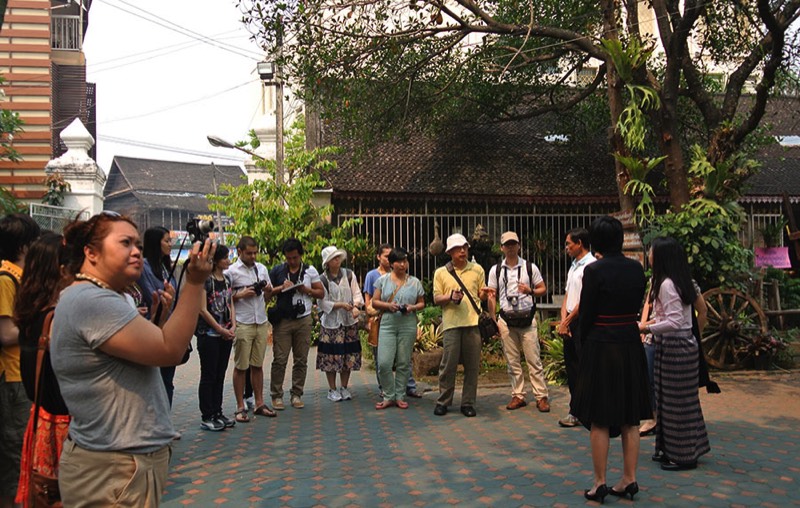
PAHSA students from the first short program in Southeast Asia visit Wat Ket Karam, a Buddhist temple in Chiang Mai, Thailand
PAHSA is part of "Campus Asia." Supported by the Ministry of Education, Culture, Sports, Science and Technology in Japan
Download the PAHSA Brochure
PAHSA sister sites
.gif)
